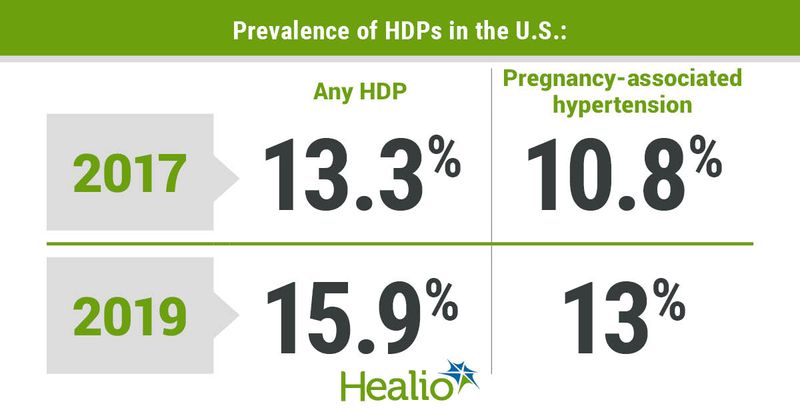About one in seven hospital deliveries affected by hypertensive disorders of pregnancy
Hypertensive disorders of pregnancy affected one in seven hospital deliveries in the United States between 2017 and 2019, mainly due to pregnancy-related hypertension, according to a report published in MMWR.
Nicole D. Ford, PhD, an epidemiologist in the CDC’s Division of Reproductive Health at the National Center for Chronic Disease Prevention and Health Promotion (NCCDPHP), and colleagues determined the annual prevalence of hypertensive disorders of pregnancy (HDPs) using data from the National Inpatient Sample.

From 2017 to 2019, the prevalence of HDPs rose from 13.3% to 15.9%, with pregnancy-associated hypertension increasing from 10.8% to 13% and chronic hypertension increasing from 2% to 2.3% in those years.
The prevalence of HDPs was highest among women aged at least 35 years who lived in areas within the lowest quartile for median household income or who were hospitalized for delivery in the South or Midwest.
Further analyses revealed that HDPs were most common among non-Hispanic Black women (20.9%; 95% CI, 20.5%-21.2%) and non-Hispanic American Indian and Alaska Native women (16.4%; 95% CI, 15.4%-17.5%).
“As health care professionals, we must recognize the factors that contribute to racial inequities and work individually and collectively to reduce these rates,” study author Wanda Barfield, MD, MPH, director of CDC’s Division of Reproductive Health, said in a CDC press release.
Additionally, the researchers noted that HDPs are one of the top causes of pregnancy-related death in the U.S., and therefore examined the prevalence of in-hospital deaths in patients with an HDP diagnosis. Data showed that 31.6% of deaths during hospitalization for delivery had HDP documented.
“There are many strategies that clinicians can use to identify, monitor and manage people with hypertensive disorders in pregnancy to prevent severe complications and deaths,” Janet Wright, MD, FACC, director of CDC’s Division of Heart Disease and Stroke Prevention at the NCCDPHP, said in the release. “A great example is home-monitoring of blood pressure during and following pregnancy. At a systems level, intentional programming like perinatal quality collaboratives can improve the quality of care and health outcomes and translate findings into interventions.”
References:
- CDC Press Release: Hypertensive disorders in pregnancy affect 1 in 7 hospital deliveries. https://www.cdc.gov/media/releases/2022/p0428-pregnancy-hypertension.html. Published April 28, 2022. Accessed April 28, 2022.
- Ford ND, et al. MMWR Morb Mortal Wkly Rep. 2022;doi:10.15585/mmwr.mm7117a1.

